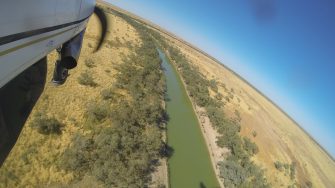
Date: Monday, October 7, 2019
Project: Eastern Australian Waterbird Survey
Observers: John Porter & Shannon Dundas
Pilot: Tim Dugan
It’s a clear still morning – perfect for flying but we know that high temperatures are predicted. We leave Windorah and head for the Diamantina River flood plain; it’s the first of several major arid river floodplain we will survey today – the others are the Georgina and Mulligan river systems. We fly down the complex braided channels of the Diamantina – only the deepest waterholes and billabongs still hold water after the February floods and there are relatively few waterbirds.
The Diamantina river channels were mostly dry.
A little bit further west we come to the Georgina river floodplain and there are several big wetlands full of water – Lakes Mipia, Koolivo and Machattie. Lake Machattie is large (>18,000ha), and today it is a spectacular site, supporting thousands of waterbirds including Grey teal, pink eared duck, black duck, freckled duck, herons cormorants ibis and spoonbills, terns, black tailed native hens, pelicans and migratory waders.
Counting over Lake Machattie
A little further west are the saline wetlands that fill from the Mulligan River - Lakes Torquinnie and Mumbleberry. They also supporting thousands of waterbirds – but not as densely distributed as on the Georgina river wetlands. We find moderate numbers of grey teal pink eared ducks, black ducks freckled ducks, migratory waders, egrets, herons, brolgas and avocets.
Counting over Lake Torquinnie
From here we turn south and refuel at Birdsville before continuing on to survey band 7.
Our first target on survey band 7 is the Diamantina again – and there are several large claypans holding water, including Lake Uloowarranie. It’s a shallow productive habitat and we find thousands of waterbirds – mainly pink eared duck, grey teal, wood duck, spoonbills and stilts.
Waterbird counting on Lake Uloowarranie.
Further west we pass near Lake Yamma Yamma which is dry and then Cooper creek floodplain which is mostly dry. As we move further eastwards the landscape becomes progressively drier and there are few natural wetlands holding water. Our final stop for the day is Charleville.
